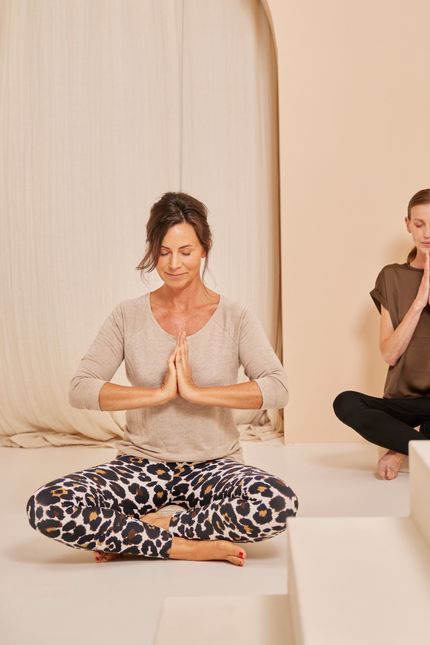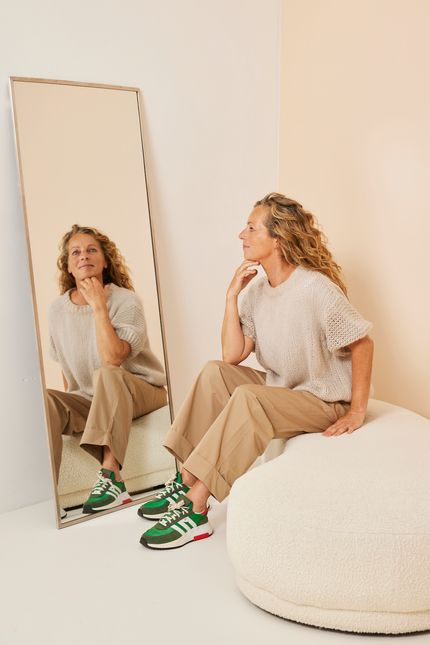Osteoarthritis and menopause
When women stop having menstrual periods, around the age of 50, their risk of osteoarthritis increases. Declining oestrogen levels are partly to blame: oestrogen keeps the cartilage and bones healthy, strong and supple. The symptoms and progression of osteoarthritis can vary from person to person. Unfortunately, osteoarthritis generally gets worse over time. However, lifestyle and dietary changes can help reduce the symptoms. How can you keep your body healthy and osteoarthritis at bay?

With menopause behind me, I presumed the worst was over. Then I got osteoarthritis. I actually thought it was an old people’s disease. - Annette (age 60)

According to an estimation of the World Health Organization (WHO) approximately 528 million people worldwide were living with osteoarthritis in 2019. About 73% of people living with osteoarthritis are older than 55 years. Osteoarthritis is more common in women than men, which may be linked to low oestrogen levels around menopause.
What is happening in your body?
Osteoarthritis (OA) is a condition where the cartilage in the joints gradually deteriorates, causing them to become painful and stiff. The underlying bone may also begin to change. The joints themselves are not affected, only the tissue around them that enables frictionless joint motion.
When levels of oestrogen and progesterone start to decline around menopause it can affect your cartilage, the connective tissue in your joints. Oestrogen helps your body maintain cartilage and keeps mucous membranes moist. When the amount of oestrogen in the body decreases, the cartilage can become thinner and mucous membranes start to lose moisture. You may notice that your eyes, vagina or mouth feel drier.
The drop in the levels of oestrogen and progesterone also affects your joints. The cartilage that cushions the ends of the bones in your joints deteriorates – it becomes thinner and less flexible. Eventually, if the cartilage wears down completely, bone will rub on bone. This friction causes pain, irritation, and inflammation.
The role of sex hormones in the development of osteoarthritis has not yet been scientifically established beyond doubt. However, there does seem to be a connection between menopause and osteoarthritis. It has been shown that oestrogen is important for maintenance of the bones, joints and cartilage, and many women develop osteoarthritis or joint pain in their menopausal years.
Other factors, or a combination of factors, may also play a role in the development of osteoarthritis: obesity, sports that put stress on your joints, strenuous physical work, bone fractures, congenital joint defects, or heredity factors.
Falling hormone levels can also trigger a variety of menopausal symptoms, such as hot flashes, sleep problems and mood swings.
What are the signs of osteoarthritis?
Joint pain is a common symptom of perimenopause and menopause. You may notice it in your hips, fingers or knees. This does not necessarily mean that you have osteoarthritis, but it can be a sign of an underlying problem. The typical symptoms of osteoarthritis include:
- Joint pain (most frequently in the small joints of the hands, wrists, fingers and big toe, though other joints in the body, such as the knees, neck, lower back and hips may experience pain as well). The more pressure on the joints, the more pain you may have.
- Joint stiffness, especially when getting up from a lying or sitting position
- Reduced movement
- Reduced flexibility
- If the joints are red, swollen, painful or warm, this is a sign of inflammation.
The presence of joint or muscle pain does not mean that you have osteoarthritis, but it may be an indication of a health issue. If the pain persists, you should seek help from a health professional to make the correct diagnosis.
Bouchard's nodes in menopausal women
Ever wondered what is causing the pain in your fingers and hands? Bouchard's nodes are a typical symptom of osteoarthritis of the hands. The disease affects postmenopausal women in particular and causes the middle joint of the finger to become painful and stiff. No reason to panic though: there are things you can do to ease the pain and improve your quality of life.
What can you do?
Osteoarthritis cannot be cured but, with the right interventions, it can be managed or even prevented.
- Keep moving. Be physically active every day. Regular physical activity helps keep your body supple and strong, including your bones and joints. Keep moving, even if you feel uncomfortable or stiff. Low-impact, muscle-building activities, such as Pilates or yoga, cycling, swimming or water aerobics, are good for managing osteoarthritis.
- Get up from your desk every hour. Most of us, in particular office workers, have a too-sedentary lifestyle. Did you know that an inactive lifestyle, with too much sitting and not enough exercise, is bad for you? Make sure you get up from your desk every hour (or even better, every 30 minutes), introduce walking meetings to your team, or get into the habit of taking walks over lunch.
- Make healthy and varied food choices. Cartilage needs nutrients to stay healthy and strong. If a diet is lacking in nutrients, the cartilage is one of the first components of the body to deteriorate. So make sure your diet contains enough nutrients, or take a multivitamin and mineral complex to fill any nutritional gaps.
- Omega-3 is super important, because fatty acids have anti-inflammatory properties.
- Are you overweight? Try to lose some pounds. Being overweight puts extra pressure on your joints and increases joint pain. Maintaining a healthy weight is therefore very important for bone and joint health.

Medication for osteoarthritis
Osteoarthritis can be prevented by maintaining healthy body weight and regular exercise. However, this isn’t always enough to relieve joint pain. Some cases may require medication.

What treatment is right for you?
Anti-inflammatory drugs (NSAIDs), such as Etoricoxib, Meloxicam and Arcoxia, are more potent than regular painkillers. They don’t only reduce pain, but also inflammation and swelling.
Can hormone therapy help?
Hormone replacement therapy (HRT) replaces lost hormones to counteract the effects of menopause. Hormone replacement therapy can be an effective way to treat severe symptoms, such as hot flashes, sleep problems and mental health symptoms. Do you have other menopausal symptoms besides osteoarthritis? Then hormone therapy might be an option for you.

I'm finally able to move around without pain, thanks to a combination of the right supplements and anti-inflammatories. Sometimes a healthy lifestyle just isn't enough. - Laura (age 53)

Sources
de Klerk BM, Schiphof D, Groeneveld FP, Koes BW, van Osch GJ, van Meurs JB, Bierma-Zeinstra SM. (2009). No clear association between female hormonal aspects and osteoarthritis of the hand, hip and knee: a systematic review. PMID: 19608726.
Karsdal MA, Bay-Jensen AC, Henriksen K, Christiansen C. (2012). The pathogenesis of osteoarthritis involves bone, cartilage and synovial inflammation: may estrogen be a magic bullet? PMID: 23024184.
Molendijk E, Schiphof D, Oei EHG, de Vos RJ, Bos PK, van Meurs JBJ, Lubberts E, Zillikens MC, van der Eerden BCJ, Kavousi M, Schouten BWV, de Rooij-Duran MIB, Bierma-Zeinstra SMA. (2022). Accelerated menopausal changes as human disease model 'FOCUM' for the development of osteoarthritis and other degenerative disorders: protocol for a prospective cohort study. PMID: 36375984.
Centers for Disease Control and Prevention. (2020). Osteoarthritis (OA). https://www.cdc.gov
Kemmler W, Shojaa M, Kohl M, von Stengel S. (2020). Effects of Different Types of Exercise on Bone Mineral Density in Postmenopausal Women: A Systematic Review and Meta-analysis. PMID: 32785775.
Waller B, Munukka M, Rantalainen T, Lammentausta E, Nieminen MT, Kiviranta I, Kautiainen H, Häkkinen A, Kujala UM, Heinonen A. (2017). Effects of high intensity resistance aquatic training on body composition and walking speed in women with mild knee osteoarthritis: a 4-month RCT with 12-month follow-up. PMID: 28263901.
Your path to a smooth menopause starts here
Get the tools you need to navigate menopause with more ease and to educate yourself about your body. With tips and insights from experts, and relatable stories of women just like you. Press play, not pause.
Tips and advice


FAQ
At what age does osteoarthritis typically develop?
Worldwide, an estimated 595 million people have osteoarthritis. It is more common in females than males. Osteoarthritis can develop at any age, but older people are more susceptible. There appears to be an increase in osteoarthritis rates in women around the age of 50, when they stop having menstrual periods. The condition often worsens over time. Adjusting your lifestyle and eating habits can help reduce the symptoms.











